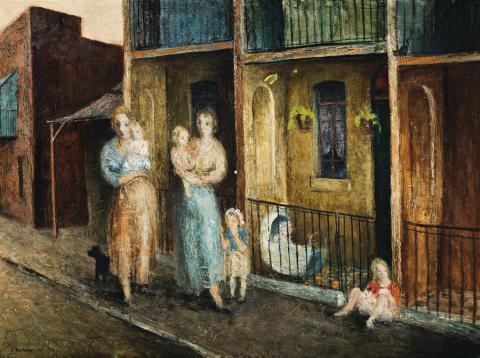THE WOMEN OF PADDINGTON, 1950
SALI HERMAN
oil on canvas
45.5 x 61.0 cm
signed and dated lower left: S. Herman, 50
Barry Stern Gallery, Sydney
Private collection, Sydney
The rich vein of humanitarianism that runs throughout Sali Herman's art finds idealexpression in The Women of Paddington 1950. The older parts of inner Sydney, ofPaddington and Woolloomooloo and their Victorian terraces attracted Herman during theforties as much as the people and street life around them. He was so fascinated by theircharacter, both architectural and human, that he produced a series of paintings which todayare not only full of the social history of a time now past, but are also fascinating as worksof art. It began with McElhone Stairs (National Gallery of Australia, Canberra), which wasawarded the 1944 Wynne Prize, accompanied by the howls of outrage that then plaguedart prizes. Sydney Scene 1946 was acquired by Yehudi Menhuhin, The Law Courts 1946went to the National Gallery of Victoria, Melbourne, via the Felton Bequest, and the ArtGallery of New South Wales, Sydney added Near the Docks 1949 to its collections. Otherprominent private and public collectors gained similar works. Mr and Mrs Kenneth Myerchose the engaging Feeding the Cats 1952, and the state galleries in Adelaide and Perthacquired Reconstruction 1950 and Woolloomooloo 1952 respectively.
Herman painted old Sydney, then slums, with sympathy, a fresh eye and a lively mind.'Toanybody used to pictures of gum trees and the harbour,' he said,'my slum pictures werestartling. But I painted houses, because houses are part of people and people are part ofhouses.'1 These pictures are peopled with anecdote " a woman sweeps the front footpath,or stands in the doorway watching the passing parade, a child chases a dog, and othersplay in a vacant lot. The relaxed and casual continue in The Women of Paddington wheretwo young mothers chatting, hold babies in their arms, a small girl holds her mother'sskirt, a baby in a pram, and the eldest of the children sits wide-legged on the footpath. Forthose who lived in these small, often cramped terrace houses, the street offered the placeto socialize. In our painting the narrative continues in the detail of a black dog, a black catpeers inquisitively from a balcony, there are hanging baskets of flowers, and patternedtiles on the verandahs. Herman also involves the personalities of the houses themselves,as in the peeling paint. As Barry Pearce observed,'With a palette knife he plastered andscraped his pigments across the canvas so that the textures took on the very character ofthe buildings he was portraying.'2 The golden further glow enriches our painting. Throughpaintings such as these, where ideas, technique, and humanism harmonize, Sali Hermanhas long endeared himself to collectors.
1. Herman, quoted in Hetherington, J., Australian Painters: Forty Profiles, F.W. Cheshire, Melbourne, 1963, p. 77
2. Pearce, B., Swiss Artists in Australia, 1777-1991, Art Gallery of New South Wales, Sydney, 1991, p. 68
DAVID THOMAS
